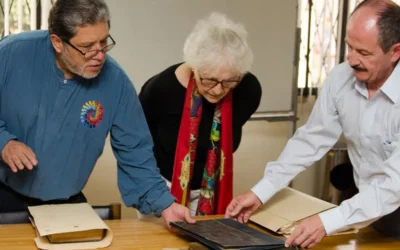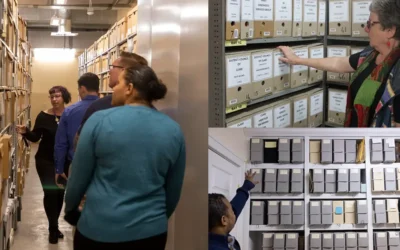Using Archival Standards to Make Data Exportable
Margot Note
An archival collections management system (CMS) should support descriptive metadata authoring and encoding, thus streamlining the discoverability of records of enduring value.
Choose a CMS compliant with standards right for the institution and holdings; archivists also use standards to make data more easily exportable and transferable between systems.
The Importance of Standards
A CMS should follow archival standards, such as DACS, EAD, MARC, RAD, ISAD (G), and Dublin Core. In addition, the collection should use thesauri, which follow international standards to describe materials. Many institutions may wish to follow select standards for their description, but they may want added field types to track unique information about their organization that fall outside the typical scope of a standard. They may also wish to store this information in a context-specific field rather than a notes field so they can harness it for more refined searches and use it as facets on their portal. A CMS can allow for the creation of fields within the preexisting standards-compliant field set, allowing archivists to capture this data as desired.
A CMS should feature fields conforming to international standards and hierarchical description, with records imported from or exported to these standards, and search strategies include Boolean and keywords. For example, the software can import scanned images from digital cameras or scanners to the records. A single record can have multiple images, which aids in describing and identifying records of enduring value. Metadata on file size, format, and location of a file is automatically imported, eliminating the need for double data entry by staff. Archivists can record added metadata, including the caption, creator, date created, resolution, size, software, and equipment used to acquire an image.
Controlled Vocabularies
Archivists can also depend upon controlling authorities to manage the use of authorized names. For example, a CMS can use ISAAR (CPF), the International Standard Archival Authority Record for Corporate Bodies, Persons and Families. This authority control organizes bibliographic information, such as a single, distinct spelling of a name. For example, I once had a client with an internally developed database without authority control. When we searched for topics, the results were incomplete because of the variety of names artists used. For example, Tupac Shakur was listed as “Tupac Shakur,” his stage name “2Pac,” and his alias “Makaveli.” One suggestion I provided as we made the system easier to use was to work with Library of Congress Subject Headings (LCSH), a controlled vocabulary of subject headings for all bibliographic records in the system.
While a CMS provides structure with its easy adaption of standards, it should also be flexible and support the full hierarchical model that historical materials often need—collections, series, and items. Archivists may use as much of the hierarchy as necessary to describe collections. Selecting the proper metadata standard and a package that can use controlled vocabularies will narrow down the choices during a CMS selection process.
EAD Encoding
A robust CMS should also allow for EAD encoding. The system automates the creation of EADs so that select top-level records and all lower levels are exported with related images and text. The EAD is exportable, allowing users to access the database when archivists export descriptive records in the EAD/XML format and backlink. Researchers can then navigate to all related materials as well as conduct more searches.
A CMS also allows for reporting, including branding, special formatting, calculations, or diagrams. Reports can print either as a PDF (Portable Document Format) file or will export the data as a CSV (Comma-Separated Values) file.
Exporting Data
As archivists select a suitable CMS for their organizations, they should look for systems with standards that allow archivists to export data. The installation of a system is an opportunity to improve archival processes. Along with system requirements, consider how archival labor can be improved by more automation, system integration, and standards—and how the system will aid the institution, its mission, and its historical collections.
Margot Note
Margot Note, archivist, consultant, and author is a guest blogger for Lucidea, provider of ArchivEra, archival collections management software for today’s challenges and tomorrow’s opportunities. Read more of Margot’s posts, and register here for her upcoming webinar, “CMS Essentials for Success #5: Export in Standard Formats” on May 19, 2021.
Similar Posts
Enhancing Collaboration; Methods for Archivists
Archivists can enhance collaboration through user-centric approaches and efficient processing methods based on customer service principles.
Navigating Selection in Archival Practice
The archival selection process is far from straightforward, given the limitations of long-term preservation and ongoing accessibility challenges.
Responsible Stewardship in Archival Practice
Responsible stewardship is a philosophy that guides the actions and decisions of archivists in safeguarding collective memory.
A Modern View of a City’s History via ArchivEra
Brief success story on City of Regina Archives’ use of ArchivEra to manage collections of legal, historical, administrative or financial significance
Hosting service
Enjoy all of the benefits of your Lucidea solution with secure, reliable, stress free hosting
Programs & incentives
No matter your size or budget, we’ve got you covered, today and tomorrow




Leave a Comment
Comments are reviewed and must adhere to our comments policy.
0 Comments